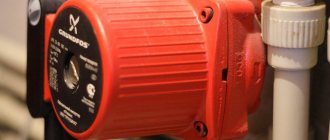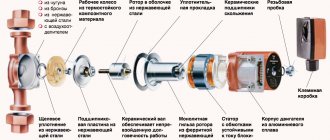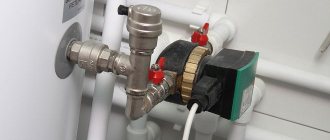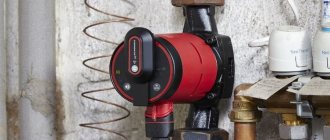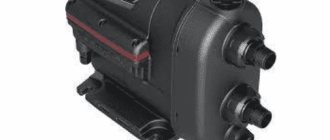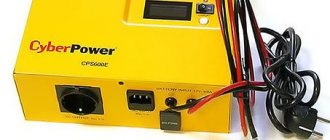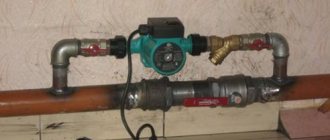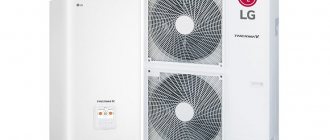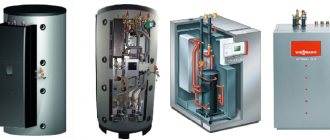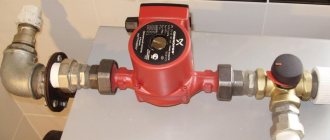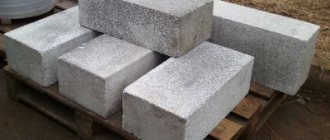Here you will learn:
- Structure of heating systems
- What is an uninterruptible power supply?
- Types of uninterruptible power supplies
- How to choose an uninterruptible power supply
- How to make an uninterruptible power supply for a heating pump with your own hands
- Factory models
The use of heating systems with forced circulation of coolant forces us to consider providing backup power for the pumps used in them. Otherwise, cutting off the power will cause the circuit to stop. For power backup, an uninterruptible power supply is required for the heating pump. Using charged batteries, it will provide the pumping unit with alternating current at the required voltage. It is this equipment that will be discussed in our review.
Why does the circulation pump need a UPS?
The use of forced circulation of coolant in modern individual heating systems is not uncommon nowadays. The use of circulation pumps in autonomous heating systems not only significantly increases their productivity, but in some cases is the only way to provide heat to residential premises, for example, those with a large area or a multi-level structure.
A serious vulnerability of such heating systems is their energy dependence. It is obvious that even a short stoppage of coolant circulation equipment associated with power outages can lead to quite serious negative consequences.
An effective solution to the issue of quality and uninterruptible power supply for pumps used in heating, drainage and well systems is the use of uninterruptible power supplies (UPS). If there are interruptions in the power supply network, the “uninterruptible power supply” will ensure the correct operation of the pump and, accordingly, the heating system of the house.
Structure of heating systems
Thin metal-plastic and metal pipes used in modern heating systems do not allow for natural coolant circulation. Also affected by the absence of slopes, the presence of a large number of connecting fittings, the minimum internal volume of radiators and many other factors. To ensure that the coolant can circulate freely through the pipes and deliver heat to all corners of the house, circulation pumps are installed in the heating circuits.
Pumps used in heating are built according to a “wet” rotor design. Thanks to this, they are compact and silent. The pump units are powered from a household single-phase network with a voltage of 220 Volts. Despite the fact that rolling power outages are no longer practiced, the stability of the supply of electricity to houses and apartments remains a sore domestic issue.
In the absence of an uninterruptible power supply, each power outage leads to difficult circulation or even its cessation. The house becomes cooler, and the heating boiler, diagnosing overheating of the boiler water, turns off. If the “lights” are turned off for several hours and there is no thermal insulation, soon the air temperature will begin to drop - the conditions for staying in the rooms will not be the most comfortable. There is only one conclusion - you need an uninterruptible power supply.
Choosing a UPS for a circulation pump
For those who want to protect themselves from unexpected power outages, we have made a small selection of mandatory parameters that should be focused on first.
Outgoing current parameters
As mentioned above, a distinctive feature of a proper UPS is a clean or correct sine wave of the output signal. Deviations in the sinusoid are unacceptable. For the proper operation of a gas and solid fuel boiler with circulation pumps, such devices with dubious characteristics are absolutely unsuitable.
Before purchasing, you should look at the product data sheet and ask what type of sine wave this UPS has.
Starting power
For reliable operation of the UPS, it will be better if its power is sufficient to meet all the needs of the connected equipment. In this option, we are more interested in having enough power to operate the boiler circulation pump. It's best if UPS covers the stock by at least five times. And it’s even better if it is 7 times more than the calculated value.
You can find out the power consumption of an electric pump for a boiler room from its technical data sheet.
Choice
The first thing to consider when choosing an uninterruptible power supply:
- Circulation pump power.
- Its energy consumption class.
- The time for which the lights are turned off.
Why do you need to know the energy consumption class? Let's say we have a 45 W pump. At the moment of startup, a power surge occurs, i.e. it will consume more watts. It is important that it does not exceed the capacity of the UPS. If you have a class A pump, the frequency converter reduces the starting torque to 1.5 times the normal power. Then the maximum power indicator will be 45x1.5=67 W.
If you do not know the energy consumption class of the pump, it is better to play it safe and take a factor of 6. Then the calculation will look like this: 45x6 = 270 W.
The operating time of the UPS will depend on the number and capacity of the batteries. However, increasing the number of batteries is not cheap and not all uninterruptible power supplies allow the use of additional battery packs.
UPSs with built-in batteries are used mostly to mitigate power surges - transforming their sawtooth shape into a smooth sine wave. In case of shutdown, they can ensure the operation of the boiler only for 20 minutes.
Another option is a UPS with a charger to which you can connect external batteries.
Battery life is calculated as follows:
(Battery capacity) x (per circuit voltage) : (total power in VA)
Note: To convert the total power from W to VA, it must be divided by 0.7.
8-12 hours of battery life is a good indicator for a UPS. And for batteries, the optimal capacity is 100A/h.
Scheme of UPS operation using Offline technology
Line-interactive or Online UPS to choose?
If the boiler is gas or diesel, On-Line devices are better suited. You can also use Linear Interactive, but additionally install a voltage stabilizer to it.
For solid fuel boilers, you can choose a cheaper linear-interactive UPS.
Mistakes that are often made when choosing a UPS:
- The battery life is determined not by the power of the device, but by the capacity of the batteries.
- If the marking contains the LT index, this means that the UPS comes with external batteries, which are not included in the price of the unit. You need to buy them additionally - without them the device will not work.
- The numbers indicated in the model are not W, but VA.
- Refrain from purchasing UPS from dubious manufacturers.
Manufacturers that have proven themselves to be reliable are Fiamm, Leoch, Delta, AQQU, CSB, Inel.
Read about what vapor-drip heaters are and where they are used in this article.
Approximate prices
A linear-interactive UPS for heating can be purchased for 5800 – 9400 rubles.
The On-Line series model will cost from 12,300 rubles. There are units for 20, 33, 75 and 100 thousand rubles.
As already mentioned, batteries are not included with the UPS - they must be purchased separately.
Depending on the model and capacity, one battery can be purchased for 2300-11000 rubles.
Purchasing and installing a UPS may seem like a waste of time and money. However, there is a possibility of losing expensive equipment and being left without heating during the cold season. And if you weigh all the pros and cons, the costs of uninterruptible power supply no longer seem so great.
What is an uninterruptible power supply?
An uninterruptible power supply for a circulation pump is a device that provides a constant supply of electrical energy. When the mains voltage decreases, the device begins to operate on one or more batteries.
The UPS consists of the following components:
- Stabilizer for the boiler. Allows you to prevent equipment breakdown due to voltage surges.
- Battery. Accumulates electrical energy, releasing it in case of disconnection from the network.
- Converter. Converts 12 V direct current into 220 volt alternating current.
- Filter. If there is a pulse converter, it blocks interference.
- Charge control indicator. Allows you to prevent critical discharge or overcharging of the device.
Appearance and design of the UPS for the circulation pump.
How to make an uninterruptible power supply for a heating pump with your own hands
Many people who are inclined to save money are accustomed to doing everything themselves. This is commendable, as it indicates the presence of brains and direct hands. To make a UPS for a heating circulation pump with your own hands, you will need additional knowledge in the field of electrical engineering - you need to assemble a converter (also known as a charge controller). If you don’t have the appropriate knowledge, then it’s better not to take it on.
As an introductory example, we present a circuit diagram of an uninterruptible power supply for a heating pump using domestic radio components.
Criteria for selecting a UPS for a circulation pump
Voltage and power
The vast majority of pumps for domestic autonomous heating systems are single-phase devices with low power consumption (from several tens to several hundred watts). Thus, single-phase UPSs of appropriate power are suitable to power the pump motor.
However, when choosing an uninterruptible power supply, you should definitely take into account the short-term, but rather high starting currents of the pump motor, which can exceed its rated power consumption by 3-5 times. Considering the economical consumption of modern circulation pumps, in most cases it will be quite sufficient to use a UPS with a capacity of 500-1000 VA.
Battery life
In the UPS operating manuals, manufacturers indicate the value of this characteristic at full load. Obviously, the actual battery life depends on the power consumption of the pump motor and the capacity of the batteries used.
Modern UPSs with built-in batteries, as a rule, have the ability to increase capacity (and, accordingly, battery life) by connecting additional external batteries.
Models that do not have standard batteries at all will be more preferable in terms of selecting the required battery capacity. Equipped with more powerful chargers, such UPSs can work with external batteries of increased capacity, providing the necessary battery life for the uninterruptible power supply.
Output waveform
The ideal voltage for powering any load is a sinusoidal voltage or one with a curve as close as possible to a sinusoid. However, often at the output, the UPS inverter in autonomous mode forms, instead of the correct one, an approximated (stepped) sinusoid or even a meander (a periodic rectangular signal in each half-cycle of the sine graph). This waveform, with its strong sinusoidal distortion, is particularly unfavorable for the AC supply voltage of electric motors and power transformers.
The operation of a circulation pump in a network with a signal such as a modified sine wave leads to unacceptable heating of the magnetic circuit of the stator and rotor due to the occurrence of additional losses and eddy currents in them. This results in reduced service life or damage to the pump motor insulation and a high risk of premature failure.
Therefore, when choosing a UPS for a circulation pump, it is very important to pay attention to the output signal form stated in the manufacturer’s specifications. To power waveform-sensitive electric drives, it must be an ideal sine wave.
UPS type
Important technical characteristics that must first be taken into account when choosing the type of uninterruptible power supply to power the circulation pump are the speed of transition to autonomous operation and the shape of the output signal.
Devices with the best combination of such characteristics are double conversion UPS (online topology) and some line-interactive type models - their use for powering pumps is less preferable for a number of reasons.
Offline (or backup) UPSs, usually with a square wave output signal (or, at best, a highly modified sine wave), fundamentally cannot be considered as suitable power sources for electric motors (in our case, circulation pumps).
The most successful choice of the presented types of UPS will certainly be online topology devices. In addition to an ideal sine wave at the output and zero transition time to offline mode, the use of double conversion devices has the following advantages over line-interactive UPSs:
- a “pure sine” signal form is provided at the output both when the load is powered from the mains and in stand-alone mode (from the battery);
- constant stabilization of the network voltage and current frequency in combination with continuous filtering of high-frequency interference in the supply network;
- very efficient operation in networks with large dips and frequent voltage drops without switching to autonomous mode;
- possibility of connecting external batteries;
- the presence of a through zero for the correct operation of phase-dependent boilers;
- the ability to perform a “cold start” - starting the pump in the absence of voltage in the supply network (in autonomous mode).
Where to buy an uninterruptible power supply for a pump in Moscow, St. Petersburg, Rostov-on-Don, Novosibirsk
You can buy reliable uninterruptible power supplies for pumps of all types and get qualified assistance in choosing a model, installation and maintenance in SKAT brand stores in the cities: Moscow, St. Petersburg, Rostov-on-Don, Novosibirsk. Addresses of stores and directions.
You can buy uninterruptible power supplies at a favorable price in our store with free delivery to the cities: Moscow, St. Petersburg, Novosibirsk, Yekaterinburg, Nizhny Novgorod, Samara, Kazan, Omsk, Chelyabinsk, Rostov-on-Don, Ufa, Volgograd, Krasnoyarsk, Perm, Voronezh, Saratov, Krasnodar, Tolyatti, Izhevsk, Barnaul, Ulyanovsk, Tyumen, Irkutsk, Vladivostok, Yaroslavl, Khabarovsk, Makhachkala, Orenburg, Novokuznetsk, Tomsk, Kemerovo, Ryazan, Astrakhan, Penza, Naberezhnye Chelny, Lipetsk, Tula, Kirov, Cheboksary , Kaliningrad, Kursk, Bryansk, Ulan-Ude, Magnitogorsk, Ivanovo, Tver, Stavropol, Belgorod, Sochi, Nizhny Tagil, Arkhangelsk, Vladimir, Smolensk, Kurgan, Volzhsky, Chita, Kaluga, Orel, Surgut, Cherepovets, Vladikavkaz, Murmansk, Vologda, Saransk, Tambov, Yakutsk, Grozny, Sterlitamak, Kostroma, Petrozavodsk, Nizhnevartovsk, Komsomolsk-on-Amur, Taganrog, Yoshkar-Ola, Novorossiysk, Bratsk, Dzerzhinsk, Nalchik, Syktyvkar, Shakhty, Orsk, Nizhnekamsk, Angarsk, Balashikha, Stary Oskol, Veliky Novgorod, Blagoveshchensk, Khimki, Prokopyevsk, Biysk, Engels, Pskov, Rybinsk, Balakovo, Podolsk, Severodvinsk, Armavir, Korolev, Yuzhno-Sakhalinsk, Petropavlovsk-Kamchatsky, Syzran, Norilsk, Lyubertsy, Mytishchi, Zlatoust, Kamensk Uralsky, Novocherkassk, Volgodonsk, Abakan, Ussuriysk, Nakhodka, Elektrostal, Berezniki, Salavat, Miass, Almetyevsk, Rubtsovsk, Kolomna, Kovrov, Maykop, Pyatigorsk, Odintsovo, Kopeysk, Zheleznodorozhny, Khasavyurt, Novomoskovsk, Kislovodsk, Cherkessk, Serpukhov, Pervouralsk, Nefteyugansk, Novocheboksarsk, Neftekamsk, Krasnogorsk, Dimitrovgrad, Orekhovo-Zuevo, Derbent, Kamyshin, Nevinnomyssk, Murom, Bataysk, Kyzyl, Novy Urengoy, Oktyabrsky, Sergiev Posad, Novoshakhtinsk, Shchelkovo, Seversk, Noyabrsk, Achinsk, Novokuibyshevsk, Yelets, Ar zamas, Zhukovsky, Obninsk, Elista, Pushkino, Artyom, Kaspiysk, Noginsk, Mezhdurechensk, Sarapul, Essentuki, Domodedovo, Leninsk-Kuznetsky, Nazran, Berdsk, Anzhero-Sudzhensk, Belovo, Velikiye Luki, Vorkuta, Votkinsk, Glazov, Zelenodolsk, Kansk, Kineshma , Kiselevsk, Magadan, Michurinsk, Novotroitsk, Serov, Solikamsk, Tobolsk, Usolye-Sibirskoye, Ust-Ilimsk, Timashevsk, Tikhoretsk, Ukhta, Sevastopol, Simferopol, Yalta, Sudak, Saki, Feodosiya, Stary Krym, Alupka, Alushta.
Operating principle of uninterruptible power supplies
An uninterruptible power supply for a heating pump (like any other) consists of a battery of one capacity or another (battery) and an automation unit. In normal mode, while the pump is powered from the mains, the electronic unit charges the UPS battery using the built-in charger and keeps it “in reserve”. When the standard voltage is lost, the same automation unit switches the consumer to power from the battery.
As a rule, the voltage and type of current required by the consumer differ from the voltage at the terminals of the backup battery, therefore almost any uninterruptible power supply contains an electronic converter - an inverter. Its task is to convert the DC voltage of the battery into that required to power the consumer (for a household circulation pump, usually 230 V / 50 Hz).
When the normal power supply is restored, the switchback occurs, and the battery is charged again. Thus, the UPS is always ready for operation and can supply power to the electrical machine at any time. How long can a UPS power the same circulation pump? Everything will depend on the battery capacity. There are uninterruptible power supply models with external batteries that can power the load for days.
One of the clear examples of such a system is a computer UPS. As soon as the mains voltage disappears, the computer will switch to battery power, giving the user time to correctly shut down and turn off the machine.
Kinds
Before choosing an uninterruptible power supply for the heating system pump, let's understand the types of these devices. There are three in total:
- backup (Off-Line or Standby);
- Line-Interactive;
- with double conversion (On-Line).
Let's look at the operating principle of each of them.
Reserve
Devices of this type include a battery, a charger, an inverter (converter) and a control system.
As long as there is voltage in the network, the load is connected to it. At the same time, the battery is charged from the same network (if necessary) and maintained in a charged state. As soon as the mains voltage disappears or exceeds the maximum critical value (optional), the control system will start the inverter and switch the load to power from it. When voltage appears in the standard network, the circuit will return to its original position.
The disadvantages of this design of the circuit are obvious:
- Switching from one source to another takes time, which means that at the moment of switching, a pulse failure will occur in the load power supply. In this case, the duration of the failure depends on the speed of the control unit, the time the converter reaches operating mode, and can reach large values. In fact, this is not an uninterruptible power supply, but a backup power source.
- If the voltage in the network “walks”, but does not go beyond the maximum permissible values required for the control system to operate, then it will “walk” at the load, greatly affecting the performance of the circulation pump.
As for the advantages, there are few of them:
- simplicity of design;
- good maintainability;
- low price.
Linear interactive
Devices of this type have the same composition, but are equipped with a voltage stabilization unit.
Its operating principle is the same as that of the backup one, but the mains voltage is stabilized at a given level. As soon as the stabilizer stops coping with its task (the voltage in the network is too low or high), the control unit will switch the load to battery power.
This design is somewhat more complicated and more expensive than the previous one, but now the circulation pump operates normally even with significant fluctuations in the network voltage. The only drawback of the linear-interactive type of devices is the rather long switching time from one power source to another.
Double conversion
The operating principle of this type of UPS is fundamentally different from the operating scheme of the previous two.
Double Conversion UPS Block Diagram
As can be seen from the diagram, the device does not have a control unit, but is equipped with a powerful step-down inverter that converts the mains voltage into constant voltage, which is necessary to charge the battery. The voltage from this inverter charges the battery and at the same time, via the same line, powers the boost inverter, to which the circulation pump is connected.
As soon as the voltage at the output of the buck converter becomes lower than the voltage at the battery terminals, the latter will begin to energize the boost converter, ensuring operation of the load. It is quite obvious that with this design of the circuit, switching from the main to the backup source will be, in fact, uninterrupted - no dips or surges. Such a device is not critical to network instability. That is, this is an ideal uninterruptible power supply, but it also has its drawbacks:
- Relatively high cost.
- The efficiency is lower than that of the two previous types.
- The forced ventilation system (for high-power UPSs) makes noise.
Criteria for selecting a backup power source
Backup power supplies designed to work with heating system pumps must be selected according to several characteristics:
- Power;
- Battery capacity;
- Acceptable battery life;
- Possibility of using external batteries;
- Input voltage variation;
- Output voltage accuracy;
- Time to switch to reserve;
- Output voltage distortion.
You should select a UPS for a circulation pump based on several basic parameters, the most important of which is power.
Determining the required UPS power
The electric motor, which is an integral part of the heating system pump, is an inductive reactive load. Based on this, the UPS power for the boiler and pump should be calculated. The technical documentation for the pump may indicate the power in watts, for example, 90 W (W). Thermal power is usually indicated in watts. To find out the total power, you need to divide the thermal power value by Cos ϕ, which can also be indicated in the documentation.
For example, the pump power (P) is 90W, and Cosϕ is 0.6. Total power is calculated using the formula:
Р/Cosϕ
Hence, the total power of the UPS for normal operation of the pump should be equal to 90/0.6=150W. But this is not the final result yet. When the electric motor starts, its current consumption increases approximately three times. Therefore, reactive power should be multiplied by three.
As a result, the UPS power for the heating circulation pump will be equal to:
P/Cosϕ*3
In the example given, the power supply will be 450 watts. If cosine phi is not indicated in the documentation, the thermal power in watts should be divided by a factor of 0.7.
Battery capacity
The capacity of the battery determines the time during which the heating system pump will operate in the absence of a network. The batteries built into the UPS usually have a small capacity, determined primarily by the size of the device. If the backup power source will operate under conditions of frequent and prolonged power outages, you should choose models that allow the possibility of connecting additional external batteries.
A very informative video about the personal experience of a person who was faced with purchasing an inverter for a boiler and heating pump, watch:
Input voltage
The mains voltage standard of 220 volts assumes permissible deviations of ± 10%, that is, from 198 to 242 volts. This means that all devices used on the territory of the Russian Federation must operate correctly within these limits. In fact, in various regions, and especially in rural areas, voltage deviations and surges can significantly exceed these values. Before purchasing a UPS for a heating pump, it will be very useful to measure the network voltage repeatedly throughout the day. The passport for the backup power supply indicates the permissible input voltage limits at which the device provides an output voltage close to the nominal value.
Output voltage and its shape
If the voltage parameters at the output of the uninterruptible power supply are within the permissible 10 percent, then this device is quite suitable for powering the heating system pump. The time it takes for the control board to switch to battery power usually does not exceed tens of microseconds. For an electric motor, this parameter is not critical.
A very important parameter of the UPS, necessary for the correct operation of the heating system pump, is the shape of the output signal. The pump electric motor requires a smooth sinusoid, which, of all models of backup power sources, can only be provided by a double conversion device or an on-line UPS. In addition to the ideal sine wave at the output, this source also produces an accurate voltage and frequency.
When installing a UPS for a heating pump, you should follow some rules:
- The room temperature must correspond to the values specified in the documentation;
- There should be no vapors of caustic reagents or flammable liquids in the room;
- The grounding circuit must be made in accordance with the operating rules for electrical installations.
Safety
When using UPS for non-stop operation of pumps in home heating systems, there are mandatory rules:
- Maintain the temperature in the room. It must comply with the recommendations specified in the technical data sheet of the product.
- Protect the device from exposure to caustic vapors of chemical reagents.
- Provide a mandatory grounding circuit.
- If a group of several batteries is used, it is not recommended to place them close to each other.
- Connect batteries of the same capacity.
- Provide fresh air to the device and batteries for cooling.
- If long-term power outages are possible, it is recommended to include an autonomous generator in the system.
Circulation pump design and UPS power requirements
The power supply requirements for circulation pumps and the requirements for uninterruptible power supplies for such pumps are determined by the design of the devices.
A modern circulation pump is a centrifugal pump with a water-cooled electric motor. Such pumps are also called “wet rotor” pumps. The following are mounted in a metal casing on a single shaft: an electric motor, an impeller with blades, a rotor, plain bearings, and control devices. A schematic representation of the design of the circulation pump is shown in the following figure.
The main design element of the circulation pump is the electric motor. Typically a highly efficient compact electric motor is used.
For these motors to operate properly, proper power supply must be provided. The electrical signal supplied to the windings of the electric motor must have the correct sinusoidal form. In the case of using power supplies with a modified sine wave, disturbances in the operation of the engine occur. In this case, the electric motor begins to heat up and hum. During long-term operation of the pump, additional wear occurs on the moving parts due to uneven rotation of the motor rotor.
In the case of a constantly reduced voltage (including at the UPS output), the current in the electric motor windings increases. The result is significant overheating of the electric motor and its failure. With reduced voltage, the circulation pump operates under increased load conditions, and a change occurs in the sound of the engine. Very low voltage may cause the pump to stall and prevent the pump from starting.
In case of increased voltage (including at the output of the UPS), the probability of breakdown of the pump motor windings increases. A significant increase in voltage leads to overheating of the pump and its failure.
A change in the frequency of the supplied current (including at the output of the UPS for the pump) leads to a change in the rotation speed of the circulation pump motor. As a result, uneven water supply leads to a reduction in the service life of the pump.
Top UPS for 36 volts with 3 batteries
Set with 3 100Ah batteries for long battery life
Uninterruptible power supplies for 36V were the first to appear on our market. 3 external batteries allow you to ensure the maximum possible battery life and reduce the load current on the batteries and inverter, which has a positive effect on reliability, including loads close to maximum.
1 place. Lanches (East) L900Pro-H 1kVA ~18,600 rub.
The first place in the ranking is occupied by the product of the large Chinese concern East (www.eastups.com). Strengths:
- Informative display
- High resistance to load problems
- Reasonable price
Flaws:
- Unstable availability at the manufacturer's warehouse in Russia
- Low charge current – 6A.
This UPS model is optimal for reliable and long backup power. Note that high-power single-phase models (3, 6 and 10 kVA) have proven themselves to be excellent for backup power supply of medical and household equipment.
2nd place. Inelt (Eltena) Monolith K1000 LT (discontinued)
Once the most popular source for connecting external batteries from the Chinese plant Kehua Tech (www.kehua.com), adapted by Russian engineers from the Inelt company for the Russian market. Pros:
- High reliability
- Average input voltage range 120-295V
Minuses
- Outdated design
- Low charge current 5A
- Uninformative display
This UPS is presented in the rating as a tribute to its high level of reliability. The lack of timely modernization, low charging current and the importer's high price policy led to the loss of this device's once very noticeable market share. In 2016, the INELT Monolith E LT 1000 model for 24V with a charge current of 6A appeared in the product line; sales and operating experience will show the quality of this product in the future.
Before purchasing and installing a UPS for a boiler, read the manual:
manual-ups-tok-shop.ru
PS In our top list of the best uninterruptible power supplies for heating boilers, we presented brands known to a wide range of market professionals. Much of what is on the market and not presented in this article is products from the same factories under other names. We hope this rating will help you choose the best option, but our company’s engineers are also at your service to help you select and install the best uninterruptible power supply for gas boilers.
Useful links:
- Ready-made UPS kits for a gas boiler with an external battery
- Guide for connecting and operating a UPS for a heating system (*.pdf 0.8mb)
- UPS Helior Sigma 1KSL: you asked - we answer
Factory models
You can buy an uninterruptible power supply suitable for its characteristics in heating and plumbing stores. They are also sold in online stores. Final prices vary depending on the manufacturer, type of equipment and technical specifications. We will look at the most popular models and give their estimated cost.
Energy PN-1000 with 75 A battery
We have a simple uninterruptible power supply with a good battery capacity of 75 A/h. With a pump power of 100 W, the battery life will be about 8 hours. The peak power is 1000 W, which is enough for any reactive load. At the output, the device produces a pure sine wave. And it refers to line-interactive UPSs, characterized by high efficiency and an affordable price. The cost of the model on the domestic market is about 260,000 rubles.
Modifications with different battery capacities are also available for sale:
- At 100 A/h – up to 11 hours when operating with a load of 100 W;
- At 55 A/h – up to 6 hours when operating with a load of 100 W;
- At 200 A/h - up to 23 hours when operating with a load of 100 W.
If power outages in your area are frequent and long-lasting, we recommend paying attention to the latest modification - its cost is 36-37 thousand rubles.
SVC DI-600-F-LCD
A compact uninterruptible power supply that can work with boilers and pumps, ensuring continuous circulation of coolant in the heating system. It belongs to the category of linear-interactive and produces a pure sine wave at the output without any distortion. The equipment does not require user intervention in its operation and provides an output voltage error of no more than 10% - this is the norm for pumps, but for boilers it could be less. The speed of switching to operation from the battery does not exceed 20 ms.
There is no built-in battery here; an external battery with a capacity of up to 200 A/h is connected to the uninterruptible power supply - this will ensure up to 24 hours of autonomous operation of the heating system. The peak load for this model should not exceed 360 W. The estimated cost of the model is 6.5-7 thousand rubles.
Tieber T-1000
If you need an uninterruptible power supply with a maximum capacity, from which the pump can operate for up to two days, you should look at this model. It works with two batteries with a capacity of up to 200 A/h each. The manufacturer recommends using maintenance-free gel batteries, as they do not emit harmful gases into the atmosphere - this is important for residential premises.
The maximum load power is 800 W. An uninterruptible power supply can power fairly powerful pumps and heating boilers, as well as units of water heated floors. The output voltage form is a pure sine wave, as required by pumping equipment motors. The device is designed for floor installation; batteries are placed next to it. The maximum charging current is 12 A/h.
Advantages of uninterruptible power supply
A progressive boiler room for a private home is a rather technically complex engineering design. In addition to the gas supply for the operation of the boilers, an electricity supply is also required for the operation of the pumps. They are responsible for the circulation of coolant through the heating system.
In case of a power outage, progressive heating systems provide automatic shutdown of the heating boiler. An emergency stop of the boiler will also cause an immediate stop in the operation of the circulation pumps. The entire heating system stops working.
If there is a short-term power outage, the level of comfort in the house will decrease for some time. As soon as the power supply is restored, everything will go as before - the house will be warm and cozy.
What if the emergency situation lasts for a long time?
It is clear that the consequences of stopping heating equipment in winter are, to put it mildly, unpleasant.
If you defrost the entire heating system, replacing the distribution network throughout the house and heating radiators is almost inevitable. Repair needed. Naturally, all this will be very expensive.
Little of.
Different heating systems circulate water differently:
- Forced (water in the system is pumped through a pump).
- Natural circulation.
If the liquid in the system stops circulating, it may simply boil and lead to an explosion.
To prevent this from happening, it is advisable to acquire a backup power supply system.
It may seem that providing your boiler with a backup source of electricity is quite simple. It seems simpler - many people have a computer uninterruptible power supply in their home. Add a car battery to them and your backup power source is ready. But it's not that simple.
Let's start with the mandatory uninterruptible power supply kit:
- UPS itself for circulation pumps;
- a set of powerful batteries;
- a set of different gauge wires and cables.
The set can be supplemented with an electricity generator.
But a gas generator needs a voltage regulator and by default is not a reliable source of energy - it can break down for a long time and this will happen at the most undesirable moment.
Therefore, first, let's look at what kind of UPS there are.
We advise you to read: about what a UPS or UPS is in more detail, about the operating principles and types of this device.
Wall-mounted and floor-standing online UPS “Shtil” for pumps
The use of the Shtil single-phase UPS models recommended below guarantees a high level of uninterrupted power supply and operational reliability of not only circulation pumps and electronically controlled heating boilers, but also any other power-sensitive electrical equipment of engineering systems in city apartments, private residential buildings or offices.
Model range of wall-mounted online UPS
The SW series is represented by fairly compact low-power devices - 250 VA, 500 VA and 1 kVA. This output power, even taking into account the high starting currents of the electric motors, several times higher than the rated ones, will be quite sufficient to power any circulation pump of the heating system.
New UPS SW250SL (250 VA) Active power, kW 0.225 Form factor on-line topology (double conversion) Limit input voltage range, V90-295 Nominal output voltage, V230 Output voltage setting range, V210-240 (requires IC-SNMP/Web monitoring card or IC-SNMP/mini-USB) Accuracy of output voltage stabilization, % ± 2 Output voltage shape pure sine wave Maximum output current, A1.2 Availability of built-in batteries Electronic automatic bypass Warranty period, months 24 Get a manual 16,200 ₽ Add to cart New UPS ST250 (250 VA) Active power, kW0.225 Form factor floor-standing Topology on-line (double conversion) Limit input voltage range, V90-295 Nominal output voltage, V230 Output voltage setting range, V210-240 (requires IC-SNMP/Web or IC-SNMP/mini-USB monitoring card) Accuracy output voltage stabilization, % ± 2 Output voltage form pure sine wave Maximum output current, A1.2 Presence of built-in batteries (optional) Electronic automatic bypass Warranty period, 24 months Get a manual 18,900 ₽ Add to cart New UPS SW250 (250 VA) Active power, kW 0.225 Form factor wall-mounted ologyon- line (with double conversion) Limit input voltage range, V90-295 Nominal output voltage, V230 Output voltage setting range, V210-240 (requires IC-SNMP/Web or IC-SNMP/mini-USB monitoring card) Output voltage stabilization accuracy, %± 2Output voltage form pure sine waveMaximum output current, A1.2Presence of built-in batteries (optional)Electronic automatic bypass Warranty period, months 24 Get a manual 16,480 ₽ Add to cart New UPS SW250LD (250 VA) Active power, kW0.225Form factor wall-mounted Topology on-line (with dual transformation) Limit input voltage range, V90-295 Nominal output voltage, V230 Output voltage setting range, V210-240 (requires IC-SNMP/Web or IC-SNMP/mini-USB monitoring card) Output voltage stabilization accuracy, %±2 Output voltage shape pure sine wave Maximum output current , A1,2 Availability of built-in batteries no Electronic automatic bypass Warranty period, months 24 Get the manual 17,580 ₽ Add to cart UPS SW500SL (500 VA) Active power, kW 0.4 Form factor wall-mounted Topology on-line (with double conversion) Limiting input voltage range, V 90-295 Nominal output voltage, V220 Output voltage setting range, V220-240 Accuracy of output voltage stabilization, % ± 2 Output voltage shape pure sine wave Maximum output current, A2.3 Availability of built-in batteries Electronic automatic bypass Warranty period, months 24 Get manual 21,280 ₽ Add to cart
Sources
- https://www.shtyl.ru/support/articles/osobennosti-vybora-ibp-dlya-nasosa/
- https://VashUmnyiDom.ru/elektropitanie/ups/besperebojnik-dlya-nasosa-otopleniya.html
- https://bespereboynik.ru/dlya-nasosov/
- https://OmShantiDom.ru/montazh-i-remont/ibp-dlya-cirkulyacionnogo-nasosa.html
- https://Acums.ru/bespereboyniki-i-bloki-pitaniya/dlya-nasosa-otopleniya-tsirkulyatsionnogo-kak-vybrat-ibp-kakoy-akkumulyator
- https://nasos-kitai.ru/proizvoditeli-nasosov/besperebojnik-dlya-nasosa-otopleniya-i
- https://teplo.bast.ru/articles/ibp-cirkulyacionnogo-nasosa-otopleniya
- https://remont-system.ru/komplektuyushchie/bespereboynye-bloki-pitaniya-dlya-cirkulyacionnyh-nasosov
[collapse]
Varieties
There are 2 main types of uninterruptible power supply:
The first type is the simplest option, since it lacks such an important detail as a voltage stabilizer. If this equipment is disconnected from the electrical supply, it will charge itself from its existing batteries.
The second type is also called a double conversion uninterruptible power supply. It has a special system that allows you to stabilize the voltage, so equipment can even be connected through it to a generator. Such systems, thanks to the automation installed in them, are able to properly control the level of charge remaining in the battery.
If there are power outages, the battery is automatically put into operation. When electricity is supplied again, the system returns to normal operation. It is worth noting that this type of uninterruptible power supply will be quite expensive.
Blitz tips
- When assembling an uninterruptible power supply, thick copper wires are used to connect the elements together, and all areas where they are connected to the equipment are made the strongest. Also, these areas need to be checked from time to time, otherwise the copper may oxidize, which will significantly impair the performance of the structure.
- If the UPS is not sealed . then dust will periodically penetrate inside, which can negatively affect its operation, so you will have to open it and clean it from time to time.
- If overloaded regularly, the inverter may fail. Another problem in its operation may be related to the lubricant on the cooling fans. If it dries out, the device will simply overheat and stop working.
- You should not connect devices of a different type and purpose to this equipment
- It's better to buy models . that work with phase-dependent devices.
Source of the article: https://teplosten24.ru/ibp-dlya-tsirkulyatsionnogo-nasosa-otopleniya-svoimi-rukami.html

